CAA News Today
Women’s History Month and Art Journal Open
posted by CAA — Mar 21, 2022
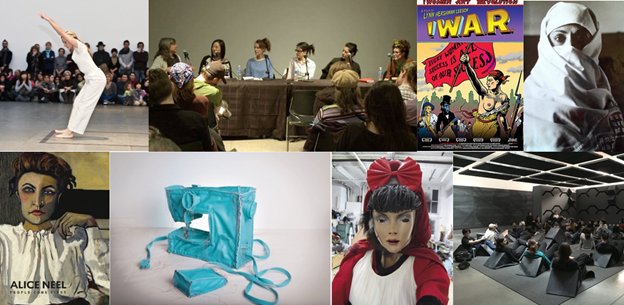
Each week this Women’s History Month, we highlight the rich scholarship and programs produced at CAA that celebrate women in the fields of visual arts and the humanities. This week, we are sharing a bibliography of articles from our open-access journal Art Journal Open that feature women artists.
This Women’s History Month is also especially significant this year, which is the 50th anniversary of feminism at CAA. To learn more about this history, visit this page. CAA is also collecting archival materials to better understand and document the history of its Committee of Women in the Arts, including the committee’s many collaborations with other affiliate committees and groups, such as the Women’s Caucus for Art, The Feminist Art Project, the Queer Caucus, and many more. Visit this page for more information.
 |
Andrew, Nell. “DadaDance: Sophie Taueber’s Visceral Abstraction.” Art Journal Open (July 3, 2014).
Sophie Taueber-Arp, Free Vertical-Horizontal Rhythms (Rythmes verticaux-horizontaux libres), 1919, gouache, 11 15⁄16 x 8 9⁄16 in. (30.3 x 21.8 cm). Stiftung Hans Arp und Sophie Taeuber Arp e.V., inv. 003.205 (artwork in the public domain; photograph provided by Stiftung Hans Arp und Sophie Taeuber Arp) |
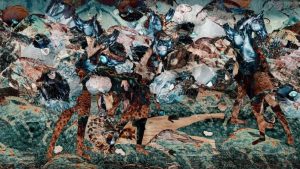 |
Barakeh, Zeina. “Projections for the Third Half [Cloud Storm].” Art Journal Open (August 6, 2020).
Zeina Barakeh, Projections From The Third Half [Cloud Storm], 2020, animation, 3 min. (artwork © Zeina Barakeh) |
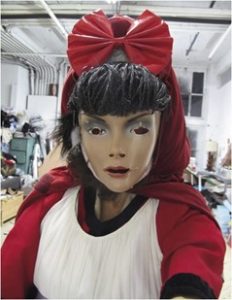 |
Barber, Tiffany E. “Narcissister, a Truly Kinky Artist.” Art Journal Open (March 11, 2020).
Narcissister, Red Riding Hood, 2014, mixed media (photograph provided by the artist) |
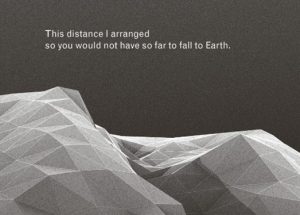 |
Berrigan, Caitlin and Sasha Engelmann. “Fault Lines and Fractures: A Conversation about Imaginary Explosions.” Art Journal Open (December 17, 2020).
Caitlin Berrigan, excerpt from Imaginary Explosions, 2018 |
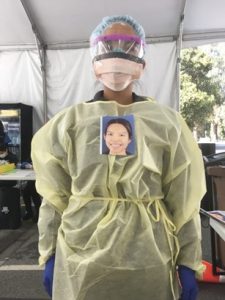 |
Bryan-Wilson, Julia and Mary Beth Heffernan. “Facing Social Practice: Mary Beth Heffernan in conversation with Julia Bryan-Wilson.” Art Journal Open (June 30, 2020).
Stanford Express Care nurse Anna Chico, who was among the first providers to use PPE Portraits for COVID-19 care, March 2020 (photograph by Cati Brown-Johnson) |
 |
Burns, A.K. and Melissa Ragain. “Scripting A Smeary Spot.” Art Journal Open (December 8, 2017).
The late Jack Doroshow performs as Mother Flawless, a clairvoyant psyche. In this scene she recites an excerpt from Joanna Russ’ sci-fi novel We Who Are About To. . . , A.K. Burns, video still from A Smeary Spot, 2015, four-channel video installation, HD color, six-channel sound, TRT 53:13 (artwork © A.K. Burns; image provided by the artist, Callicoon Fine Arts, NY, and Michel Rein Gallery, Paris/Brussels) |
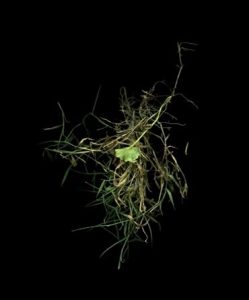 |
Cancelmo, Amy. “Roots and Ramble Kija Lucas and Amy Cancelmo in Conversation.” Art Journal Open (August 30, 2016).
Kija Lucas, Bristol 30, 2013, archival pigment print, 20 x 24 in. (50.8 x 60.9 cm), from In Search of Home, (artwork © Kija Lucas) |
 |
Carland, Tammy Rae and Ann Cvetkovich. “Sharing an Archive of Feelings: A Conversation.” Art Journal Open (October 24, 2013).
Tammy Rae Carland, Galz Living Room, MWMF, from Outpost, 2004, color photograph, 20 x 24 in. (50.8 x 61cm) (artwork © Tammy Rae Carland) |
 |
Costello, Kate. “P&P .” Art Journal Open (November 3, 2016).
Still from Kate Costello, P&P, 2016, video, 1 min., 26 sec. (artwork © Kate Costello) |
 |
Craycroft, Anna. “To Listen.” Art Journal Open (October 25, 2017).
Sophomore Seminar with Meg Cranston and Marlena Donohue, April 5, 2017: Meg Cranston and Marlena Donohue’s class met with Anna Craycroft to discuss Tuning the Room in relation to Umberto Eco’s essay “The Open Work.” (artwork © Anna Craycroft) |
 |
Craycroft, Anna. “To Record, to Interpret, to Comment.” Art Journal Open (March 1, 2017).
Anna Craycroft, The Earth Is a Magnet, 2016, installation view, part of The Artist’s Museum, Institute of Contemporary Art Boston, November 16, 2016–March 26, 2017 (artwork © Anna Craycroft; photograph by Charles Mayer) |
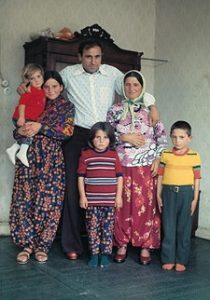 |
DaPonte, Amy A. “Candida Höfer’s Turken in Deutschland as ‘Counter-publicity’.” Art Journal Open (January 6, 2017).
Candida Höfer, Untitled from Türken in Deutschland 1979, 1979, color slide projection, 80 slides, approx. 7 min., dimensions variable (artwork © Candida Höfer, Köln/VG Bild-Kunst, Bonn 2016) |
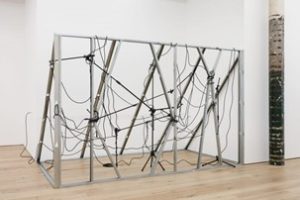 |
Fuenmayor, Jesús. “Barricades of Silence: Nikita Gale in Conversation with Jesús Fuenmayor.” Art Journal Open (August 20, 2020).
Nikita Gale, INTERCEPTOR, 2019, installation view, Fall Apart: Nikita Gale & Pat O’Neill, Martos Gallery, New York, January 11–February 24, 2019 (artwork © Nikita Gale; photograph by Charles Benton/Martos Gallery, provided by the artist) |
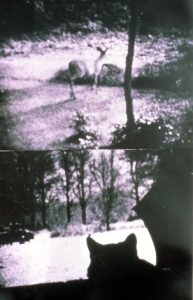 |
Goodeve, Thyrza Nichols. “The Cat is My Medium: Notes on Writing and Art of Carloee Schneemann.” Art Journal Open (July 29, 2015).
Carolee Schneemann, Kitch’s Last Meal, 1973–76, Super 8mm film, double projection, vertical, sound on cassette, ca. 5 hrs., two installation views (artwork © Carolee Schneemann; photographs provided by the artist) |
 |
Goulish, Matthew. “A Clear Day and No Memories: Neurology, Philosophy, and Analogy in Kerry Tribe’s HM.” Art Journal Open (February 5, 2014).
Eadward Muybridge, Pi-Wi-Ack, Valley of the Yosemite (Shower of Stars), “Vernal Fall,” 400 Feet Fall, No. 29, 1872, wet-plate collodion photograph (photograph in the public domain) |
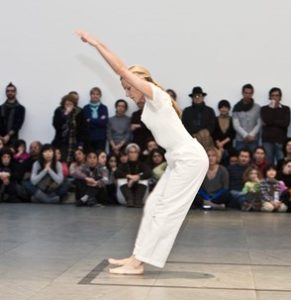 |
Graham, Amanda Jane. “Space Travels: Trisha Brown’s Locus.” Art Journal Open (July 22, 2016).
Trisha Brown, Locus Solo, 2011, performed by Diane Madden in “Performance 11: OnLine/Trisha Brown Dance Company” in conjunction with the exhibition On Line: Drawing through the Twentieth Century, Museum of Modern Art, New York, January 2011 (photographs © Yi-Chun Wu; photographs provided by Museum of Modern Art/Licensed by SCALA/Art Resource, NY) |
 |
Jenkinson, Monique. “Diva Maw.” Art Journal Open (October 29, 2020).
Monique Jenkinson (Fauxnique), Diva Maw, 2020, digital video, 5:35 min.; soundtrack by Marc Kate, Untitled (“Diva Maw” Soundtrack), 2020, audio file (video © Monique Jenkinson; soundtrack © Marc Kate) |
 |
Kauffman, Vanessa. “Outside of Time: Patricia Fernández Carcedo in Conversation with Vanessa Kauffman.” Art Journal Open (August 12, 2016).
Visitors in Patricia Fernández Carcedo’s studio during Headlands’ Fall 2015 Open House (artwork © Patricia Fernández Carcedo; photograph by Rebecca Puretz, provided by Headlands Center for the Arts) |
 |
Laser, Liz Magic and Christopher Y. Lew. “InterAct: a reenacted interview.” Art Journal Open (May 4, 2011)
Liz Magic Laser, Flight, 2010, performance, MoMA PS1, Long Island City, April 10, 2010 (artwork © Liz Magic Laser; photograph by Mia Tramz, provided by Derek Eller Gallery). The performance was developed in collaboration with actors Lindsey Andersen, Nic Grelli, Elizabeth Hodur, Michael Wiener, Max Woertendyke, and Lia Woertendyke |
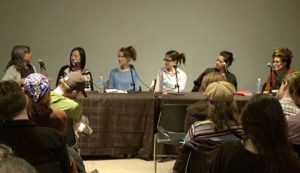 |
Lee, Young Jean. “Women in Downtown Theater.” Art Journal Open (August 26, 2012). |
 |
Leeson, Lynn Hershman. “Excerpts from the Graphic Novel !Women Art Revolution—A Secret History.” Art Journal Open (May 29, 2011) |
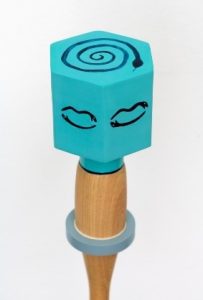 |
Mann, Elana. “One day I will make a mace, but for now I have a mouth.” Art Journal Open (September 30, 2021).
Elana Mann, Unidentified Bright Object #61, 2021, clay, wood, and glass, 14 ½ x 3 ½ x 3 ¾ in. (36.8 x 8.9 x 9.5 cm) (artwork © Elana Mann; photographs by Brica Wilcox) |
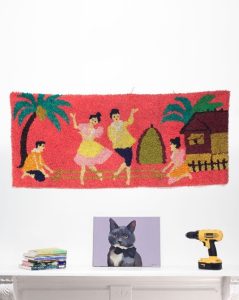 |
Masley-Charlet, Caitlin. “Caitlin Masley-Charlet in Conversation with Elisabeth Smolarz.” Art Journal Open (June 5, 2018).
Elisabeth Smolarz, ENCYCLOPEDIA OF THINGS, ongoing 2014–2017. Archival inkjet prints, dimensions variable. Courtesy of the artist. |
 |
Masley-Charlet, Caitlin. “Caitlin Masley-Charlet and Diana Shpungin in Conversation.” Art Journal Open (July 8, 2016).
Diana Shpungin, detail of A Break in One and Several Places, 2015, graphite pencil, horsehair broom, glazed porcelain and stoneware, 24 x 43 x 14 in. (60.9 x 109.2 x 35.5 cm) (artwork © Diana Shpungin) |
 |
McKee, C.C. “‘a salting of sorts’: Salt, Sea, and Affective Form in the work of Deborah Jack.” Art Journal Open (July 30, 2019).
Deborah Jack, SHORE, 2004, nylon screens, video projection, rock salt, reflecting pool, dimensions variable, installation view, Big Orbit Gallery, Buffalo, New York (artwork © Deborah Jack; photograph provided by the artist) |
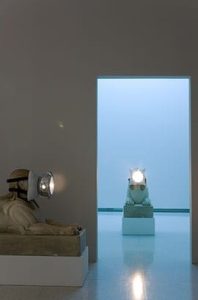 |
McClure, Michael Jay. “If it Need Be Termed Surrender: Trisha Donnelly’s Subjunctive Case.” Art Journal Open (July 29, 2013).
Trisha Donnelly, Untitled, 2008, plaster, horsehair, paint, pillow, belts, lamp, two parts, ea. 36 x 60 x 22¾ in. (91.4 x 152.4 x 57.8 cm), installation view, The Quick and the Dead, Walker Art Center, 2009 (artwork © Trisha Donnelly; photograph provided by Casey Kaplan, New York) |
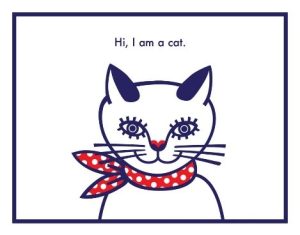 |
Ohsawa, Asuka. “Squares, Triangles, and Cats.” Art Journal Open (December 31, 2020). |
 |
Porges, Maria. “Shortest Stories.” Art Journal Open (December 20, 2018). |
 |
Rosa, María Laura. “Questions of Identity: Photographic Series by Alicia D’Amico, 1983–86.” Art Journal Open (July 2, 2019).
Alicia D’Amico photograph of Liliana, a performance by Liliana Mizrahi, 1983, scanned copy of original negative, reproduction from original 35mm negative contact (photograph © Archivo Alicia D’Amico, Buenos Aires) |
 |
Santos, Dorothy R. “ Domain Errors.” Art Journal Open (July 24, 2020). |
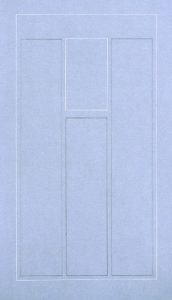 |
Schiff, Karen L. “Imprinting Agnes Martin.” Art Journal Open (December 19, 2014).
Karen L. Schiff, Agnes Martin, El País, 21 December 2004, II, 2005, graphite and stylus on vellum, 17 x 12 inches (artwork © Karen L. Schiff) |
 |
Sifuentes, Aram Han. “Official Unofficial Voting Station: Voting for All Who Legally Can’t.” Art Journal Open (October 1, 2020).
Protest Banner Lending Library, Let Us Vote! and Official Unofficial Voting Station, 2020, textile banners (photograph by Thaib A. Wahab) |
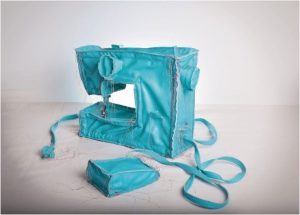 |
Szymanek, Angelique. “Haptic Encounters: Margarita Cabera’s Space in Between.” Art Journal Open (October 15, 2020).
Margarita Cabrera, Sewing Machine (Blue-Green), 2016, vinyl, thread, copper wire, and appliance parts (artwork © 2020 Margarita Cabrera/Licensed by VAGA at Artists Rights Society [ARS], NY; photograph provided by the artist) |
 |
Vlassopoulou, Penelope. “No water, Athens, Greece, 2015: Twenty-four hours with nothing to eat or drink, only smelling the jasmine.” Art Journal Open (October 26, 2016).
Excerpt from Pandelis Prevelakis, I Kefali tis Medousas [The Head of Medusa] (Athens: Friends’ Editions, 1963), trans. the artist and Markus Nystrom |
 |
Watt, Marie. “In Conversation with Marie Watt: A New Coyote Tale.” Art Journal Open (October 19, 2017).
Marie Watt, Blanket Stories: Transportation Object, Generous Ones, Trek, 2014, cast bronze, 18 x 4 x 6 ft. (5.49 x 1.22 x 1.83 m). Permanent installation, Tacoma Art Museum, Tacoma, Washington (artwork © Marie Watt; photograph by Benjamin Benschneider/OTTO) |
 |
Wilson, Siona. “Portraits (and) Matter.” Art Journal Open (January 13, 2022). |
 |
Yoshitake, Mika. “Humans have been Human for so long: Shana Lutker and Mika Yoshitake in Conversation.” Art Journal Open (August 2, 2016).
Shana Lutker, A handsome confused puppet, 2015, mirrored glass box, fluorescent lights, wood, marble, casters, 49 x 30 x 19 in. (124.4 x 76.2 x 48.2 cm) (artwork © Shana Lutker; photograph by Cathy Carver) |
 |
Yurshansky, Jenny. “Hide and Seek.” Art Journal Open (March 25, 2021).
Jenny Yurshansky, Hide and Seek (folded view), 2021, interactive sculpture, inkjet print, 3 3/4 x 3 3/4 x 3 in. (9.5 x 9.5 x 7.6 cm) (photograph provided by the artist) Folk tradition meets revisionist storytelling in Jenny Yurshansky’s printable sculpture |
Black History Month and Art Journal Open
posted by CAA — Feb 10, 2022
Each week this Black History Month, we highlight the rich scholarship and programs produced at CAA that celebrate, recognize, and interrogate Black art, history, and experience. This week, we are sharing a bibliography of articles from our online, open-access journal Art Journal Open that addresses these topics.
 Aranke, Sampada. “Objects Made Black.” Art Journal Open (February 9, 2015). Crossover article from Art Journal 73, no. 3 (Fall 2014) reviewing Huey Copeland, Bound to Appear: Art, Slavery, and the Site of Blackness in Multicultural America, Chicago: University of Chicago Press, 2013. Aranke, Sampada. “Objects Made Black.” Art Journal Open (February 9, 2015). Crossover article from Art Journal 73, no. 3 (Fall 2014) reviewing Huey Copeland, Bound to Appear: Art, Slavery, and the Site of Blackness in Multicultural America, Chicago: University of Chicago Press, 2013. |
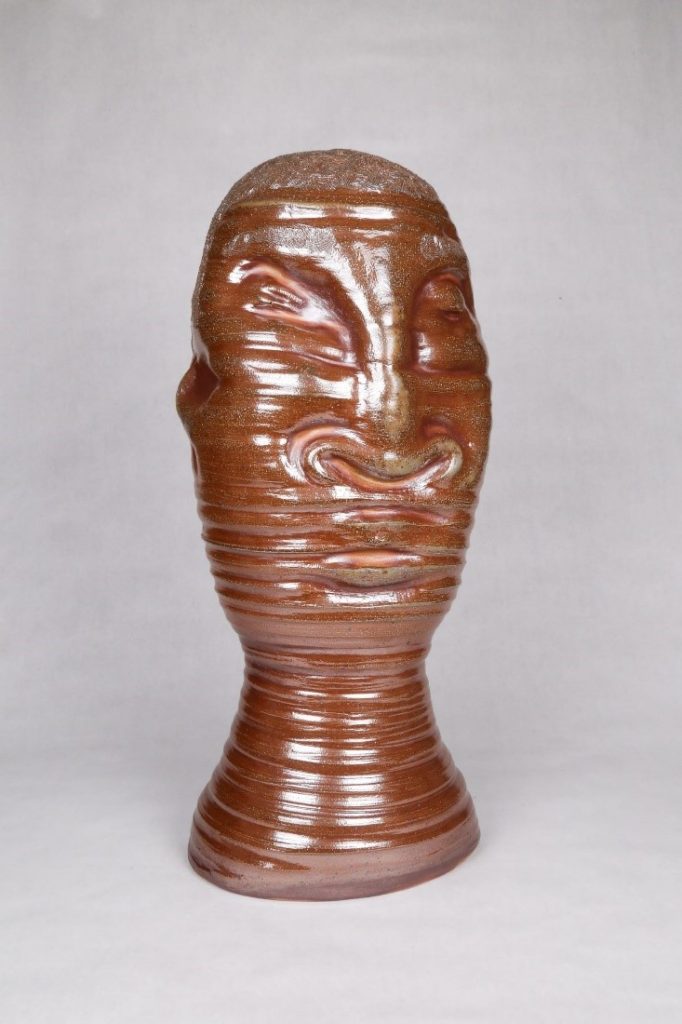
Baralaye, Ebitenyefa and Glenn Adamson. “The Weight of Matter: Ebitenyefa Baralaye and Glenn Adamson in Conversation.” Art Journal Open (May 20, 2021). Ebitenyefa Baralaye, Portrait I (multiple views), 2020, salt-glazed stoneware, 25 x 12 x 10 in.
|
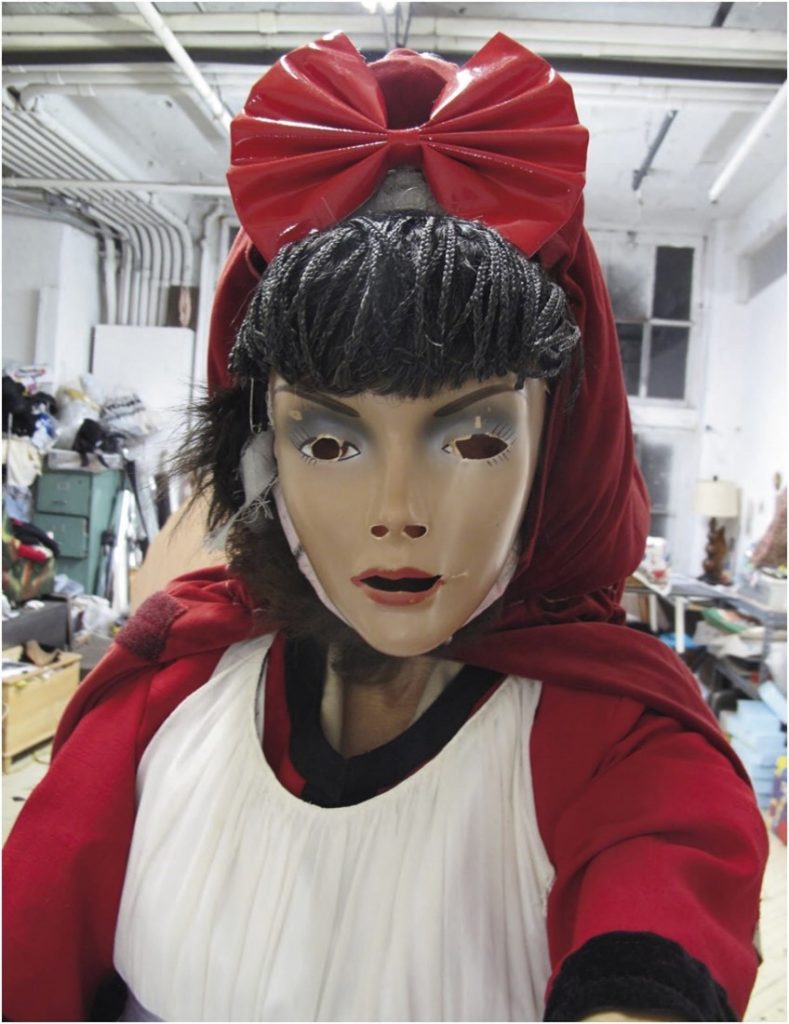
Barber, Tiffany E. “Narcissister, a Truly Kinky Artist.” Art Journal Open (March 11, 2020). Narcissister, Red Riding Hood, 2014, mixed media (photograph provided by the artist).
|
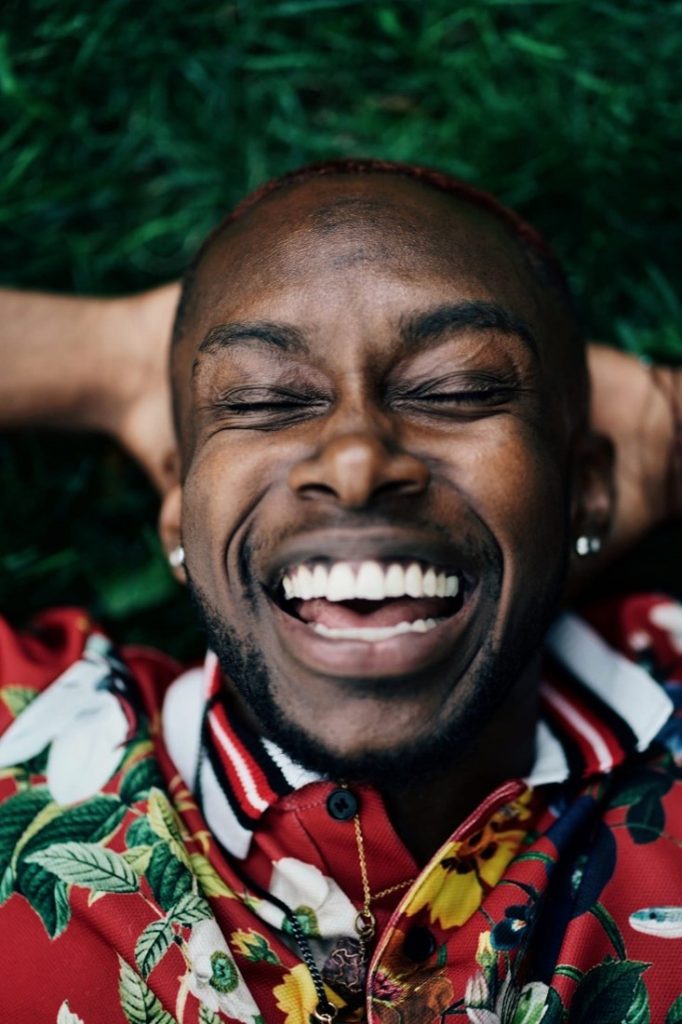
Best, Makeda. “Interview with Texas Isaiah.” Art Journal Open (April 8, 2021). Crossover article from Art Journal 80, no. 1 (Spring 2021). Texas Isaiah, don’t kill this vibe, 2018 (artwork © Texas Isaiah; photograph provided by the artist)
|
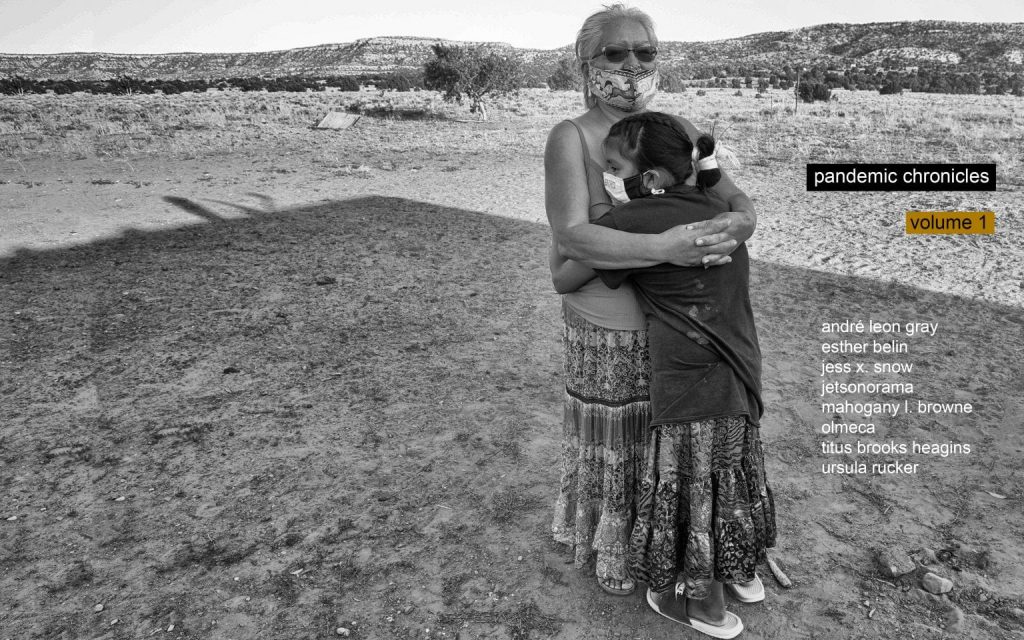
Childs, Adienne L. Riffs and Relations: African American Artists and the European Modernist Tradition. Washington, DC and New York: Phillips Collection in association with Rizzoli Electa, 2020. Sanford Biggers, Negerplastik, 2016, repurposed antique quilt, cotton fabric fragments, tar, and glitter, 81 × 76 3/4 in. (205.7 x 195 cm) (photograph by Todd-White Art Photography, provided by Massimo De Carlo, Milan/London/Hong Kong)
|
 Cunningham, Nijah. “With Each Other.” Art Journal Open (October 14, 2021). Crossover article from Art Journal 80, no. 3 (Fall 2021) reviewing Nicole R. Fleetwood. Marking Time: Art in the Age of Mass Incarceration. Cambridge, MA: Harvard University Press, 2020. Cunningham, Nijah. “With Each Other.” Art Journal Open (October 14, 2021). Crossover article from Art Journal 80, no. 3 (Fall 2021) reviewing Nicole R. Fleetwood. Marking Time: Art in the Age of Mass Incarceration. Cambridge, MA: Harvard University Press, 2020. |

Dally, Jenny and Fred Eversley. “The Object and You: Fred Eversley in Conversation with Jenny Dally.” Art Journal Open (February 25, 2021). Fred Eversley in his Venice Beach studio, 2018 (photograph by Elon Schoenholz; photograph provided by David Kordansky Gallery, Los Angeles)
|
 Gaines, Malik. “City after Fifty Years’ Living: LA’s Differences in Relation.” Art Journal Open (July 17, 2012). Gaines, Malik. “City after Fifty Years’ Living: LA’s Differences in Relation.” Art Journal Open (July 17, 2012).
Ice Cube Celebrates the Eames, poster, 2011 (artwork © J. Paul Getty Trust)
|

Gale, Nikita and Jesús Fuenmayor. “Barricades of Silence: Nikita Gale in Conversation with Jesús Fuenmayor.” Art Journal Open (August 20, 2020). Nikita Gale, INTERCEPTOR, 2019, installation view, Fall Apart: Nikita Gale & Pat O’Neill, Martos Gallery, New York, January 11–February 24, 2019 (artwork © Nikita Gale; photograph by Charles Benton/Martos Gallery, provided by the artist),
|

Gbadegesin, Olubukola A. “Damon Davis’s Negrophilia: Encounters with Black Death.” Art Journal Open (August 30, 2017). Damon Davis, Untitled (2), 2015, bookprint, ink, watercolor, adhesive, from the series Negrophilia (artwork © Damon Davis)
|

Majeed, Risham and Blake Bradford. “Just Being.” Art Journal Open (May 22, 2020). Albrecht Dürer, Portrait of a Black Man (untitled), 1508, black chalk on paper. Original shown here; the NMAAHC has a reproduction in the Middle Passage galleries.
|

Raiford, Leigh. “Burning All Illusion: Abstraction, Black Life, and the Unmaking of White Supremacy.” Art Journal Open (January 14, 2021). Samuel Levi Jones, Joshua, 2016, deconstructed Illinois law books on canvas, 61½ x 77 in. (156.2 x 195.6 cm) (artwork © Samuel Levi Jones; photograph provided by Galerie Lelong)
|
 Sifuentes, Aram Han. “How Internalized White Supremacy Manifests for My BIPOC Students in Art School.” Art Journal Open (July 8, 2021). Sifuentes, Aram Han. “How Internalized White Supremacy Manifests for My BIPOC Students in Art School.” Art Journal Open (July 8, 2021).
Cute Rage Press (Aram Han Sifuentes and Ishita Dharap), detail of Taking Receipts:
|
| Saggese, Jordana Moore, Cauleen Smith, Charles Gaines, Edgar Arceneaux, Howardena Pindell, Michael Ray Charles, and Glenn Ligon. “A Call to Artists.” Art Journal Open (October 26, 2021). Crossover article from Art Journal 80, no. 3 (Fall 2021).
|

Tani, Ellen Y. “Come Out to Show Them: Speech and Ambivalence in the Work of Steve Reich and Glenn LigonSpeech and Ambivalence in the Work of Steve Reich and Glenn Ligon.” Art Journal Open (December 23, 2019). Glenn Ligon, Come Out Study #13, 2014, silkscreen on canvas on panel, 36 x 47 7/8 in. (91.4 x 121.6 cm) (artwork © Glenn Ligon; photograph by Ronald Amstutz, provided by the artist, Hauser & Wirth, New York, Regen Projects, Los Angeles, Thomas Dane Gallery, London, and Chantal Crousel, Paris)
|

Thompson, Krista. ““I WAS HERE BUT I DISAPEAR”: Ivanhoe “Rhygin” Martin and Photographic Disappearance in Jamaica.” Art Journal Open (August 14, 2018). Production still from The Harder They Come, 1972, 16mm color film, dir. Perry Henzell, cinematography by Frank St. Juste, David McDonald, and Peter Jessop, produced by International Films / Xenon Pictures (photograph published under fair use)
|
 Williams, Stephanie Sparling. “Artful Embodiment: Genealogies of the Impossible.” Art Journal Open (November 27, 2018). Crossover article from Art Journal 77, no. 3 (Fall 2018) reviewing Uri McMillan, Embodied Avatars: Genealogies of Black Feminist Art and Performance, New York: New York University Press, 2015. Williams, Stephanie Sparling. “Artful Embodiment: Genealogies of the Impossible.” Art Journal Open (November 27, 2018). Crossover article from Art Journal 77, no. 3 (Fall 2018) reviewing Uri McMillan, Embodied Avatars: Genealogies of Black Feminist Art and Performance, New York: New York University Press, 2015. |
 Winslow, Margaret. “Pope.L: The Body and Its Void.” Art Journal Open (January 14, 2021). Crossover article from Art Journal 79, no. 4 (Winter 2020) reviewing member: Pope.L, 1978–2001., exhibition organized by Stuart Comer with Danielle A. Jackson. Museum of Modern Art, New York, October 21, 2019–February 1, 2020. Winslow, Margaret. “Pope.L: The Body and Its Void.” Art Journal Open (January 14, 2021). Crossover article from Art Journal 79, no. 4 (Winter 2020) reviewing member: Pope.L, 1978–2001., exhibition organized by Stuart Comer with Danielle A. Jackson. Museum of Modern Art, New York, October 21, 2019–February 1, 2020. |

Zorach, Rebecca. “Art and Soul: An Experimental Friendship between Street and Museum .” Art Journal Open (September 4, 2011). Art & Soul exterior with Rainbow mural by Sachio Yamashita, 1969 (mural now destroyed) (mural artwork © Eileen Petersen Yamashita, all rights reserved, used with permission; photograph © Ann Zelle)
|
Meet the 2022 CAA-Getty International Program Participants
posted by CAA — Dec 22, 2021
We’re pleased to announce this year’s participants in the CAA-Getty International Program. Now in its eleventh year, this international program supported by the Getty Foundation will all twelve new participants and four alumni to participation in the 2022 Annual Conference. Learn more about the first ten years of the program in our online publication.
At a pre-conference colloquium, the new participants will discuss key issues in the international study of art history together with CAA-Getty alumni and US hosts. The program will delve into topics as postcolonial and Eurocentric legacies, interdisciplinary and transnational methodologies, and the intersection of politics and art history.
Alumni invited back to the 2022 conference will present in the session Can Art History Be Affective? Empathy, Emotion and the Art Historian, chaired by Getty alumni and International Committee members Nora Veszpremi and Cristian Nae, while also providing an intellectual and social link between new participants and our burgeoning group of CAA-Getty International Program alumni.
The goal of the CAA-Getty International Program is to increase international participation in CAA’s activities and the field of visual arts in academia, thereby expanding international networks and the exchange of ideas both during and after the conference. We look forward to welcoming the following participants.
2022 PARTICIPANTS IN THE CAA-GETTY INTERNATIONAL PROGRAM

Tatiana Muñoz Brenes is an art curator and researcher. She has combined the exercise of cultural management with Social Sciences by having degrees in Art History and Psychology, both from the University of Costa Rica. Her training has allowed her to work on the topics of community museums, sustainability, collection research, curating exhibitions and curatorial accompaniment for artistic production. Currently, her work focuses mainly on queer art and the LGBTIQ+ community in Latin America. In addition, she has extensive experience in international projects, lectures, publications and museum training in Scotland, Portugal, Spain, China, Japan, Ecuador, and other countries. Projects can be found at www.arthistorylady.com
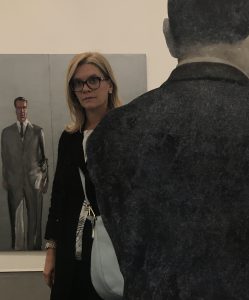
Simona Cupic is Professor at the Department of Art History, University of Belgrade, Serbia. Her fields of research and teaching include art and culture between the World Wars, and the 1950s and 1960s. She is particularly interested in the visual and popular culture between 1920s and 1960s. She is the author of Mona Lisa & Superman. John F. Kennedy and the New Frontier of the Culture (2016), Elain de Kooning. Portraits (with Brandon Brame Fortune, Ann Eden Gibson, 2015), The JFK Culture (edited volume, 2013), and Bourgeois Modernism and Popular Culture. Episodes of the Fashionable, Faddish and Modern (1918-1941) (2011), among others.
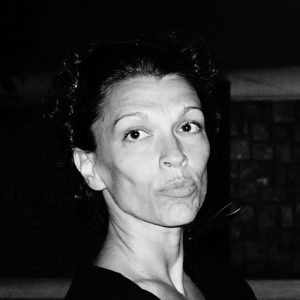
Anica Draganić is an architectural historian, conservator and multimedia artist who currently serves as an Associate Professor at the University of Novi Sad, Serbia. She received her PhD in Architectural History and Heritage Preservation from the University of Belgrade with a dissertation on Austro-Hungarian historical breweries. Her work focuses on nineteenth- and twentieth-century European architecture, with particular emphasis on industrial heritage and identity issues in the intercultural context of Central Europe. Her extensive research on the architectural heritage of the Vojvodina region has been published in journals, conference proceedings, and books, but also presented in numerous exhibitions. Her most recent book, Shadows and Silhouettes of Industrial Past of Vojvodina, shows the complexities of the socio-political context in which the industrial architecture of a specific multicultural region emerged, developed and disappeared. She is currently particularly interested in European architecture from the socialist period, exploring its historical values and contemporary potential.
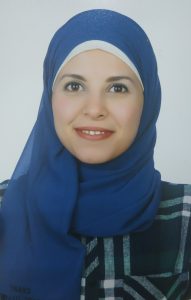
Heba Khairy Metwaly is an Exhibition coordinator at the Grand Egyptian Museum. She Oversees and provide rigorous, accurate and efficient exhibition coordination and follow up all aspects of exhibition development between all partners in the GEM. She is a PhD researcher specialized in the Collection Management and Documentation Practices in different museums. Heba has participated in many international and national field projects and studies focusing on the tangible and intangible material culture preservation and local community engagement and development. Heba has participated in the development of the daily life gallery “P34” at the Egyptian Museum of Cairo, the European Union Funding Project of Transforming the Egyptian Museum. In 2017 she participated in the British Museum International Training Program, where she curated the Object in Focus temporary exhibition. She Also participated in many international conferences focusing on the preservation of museum collection and exhibition design.

Roma Madan Soni is an art historian with a PhD from the University of Wolverhampton, an Assistant professor at Box Hill College Kuwait, an ecofeminist-artist, and a researcher. Her art, teaching, and research are interdisciplinary, positioned at the node of ecofeminism: practice, theory and history, and contemporary visual politics. Her articles are published in Journal of Visual Art Practice, Feminist Media Studies, Ecofeminism and Climate Change, Crafts Research, Art & The Public Sphere, Necsus, International Feminist Journal of Politics, Journal of Gender Studies, Swasti, and a chapter in Cambridge Scholars. She collaborated for conference presentations and conducted workshops at CAA, SVIMS-Pune, JNU, LSR, Raza Foundation, University of Wolverhampton, Kuwait-Nuqat, KISR, TEDx Global Day- Gulf University of Science and Technology, Dar Al Athar-Yarmouk, Kuwait University, American University of Kuwait, Box Hill College Kuwait, American Open University, UN Habitat and Beit Sadu. She has exhibited at Kunsthaus-Steffisburg, TAPRI-Finland, DarAlAthar AlIslamiyah, The Scientific Centre Kuwait, MOMA-Kuwait, Masaha13, Artsy, Mayinart, Artling, Saatchi galleries, and painted the book-cover for Routledge Handbook of Feminist Peace Research (2021). Research grants, commissions and awards from The Scientific Centre Kuwait, Kuwait Foundation of Advanced Sciences, Kuwait Institute of Scientific Research, UN Habitat, and Arab Open University aided her research and creations. She is a member of the Museum Committee and a Reader for the Council of Readers at CAA. I chair the “Transformative Education Think Tank”-Collective Impact Coalition-Konrad Adenauer Stiftung to address Kuwait’s academic challenges. Her work has been accepted at the Venice Art Fair and Florence Biennale 2021.
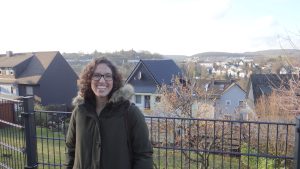
Patricia D. Meneses is an assistant professor of Art History at the University of Campinas (Brazil). She earned her PhD in History of the Visual Arts at the University of Pisa (2009). She is the author of Baccio Pontelli a Roma. L’attività dell’architetto per Giuliano Della Rovere (Felici Editore 2010) and editor of several books, such as Arte Não-Europeia. Conexões historiográficas a partir do Brasil (Esta ção Liberdade 2020), and A imagen como experimento. Debates contemporaneous sobre o olhar (Milfontes 2021). Recently, she was Hans Jonas visiting professor at the University of Siegen (2019), where she taught a course on “exotic” materials in Art History. She is currently part of a Connecting Art Histories project sponsored by the Getty Foundation (“Teaching Non-European at Brazilian Universities”). Her research focuses on the connections between art, science and ecology in the nineteenth-century. She is presently developing a book project about hummingbird’s ecology in Brazilian visual culture.
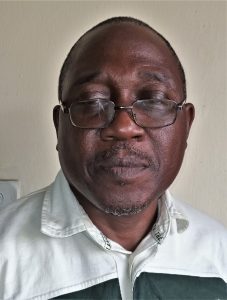
Akinwale Onipede is an art historian, researcher and teacher at the University of Lagos, Nigeria. He trained at the University of Benin, and, the University of Lagos, where he works in the area of the interface of global and local cultures and identities as expressed in visual arts. His main interest is in how developments globally in the philosophies, techniques, products and opportunities in visual arts, have affected its contemporary practice and direction in Nigeria. The universalization of cultures, consequent upon globalization, he argues, is skewed in favor of the West, whose culture is endorsed, whose pocket is deepest and whose machinery is most efficient, in the promotion of the direction of visual arts studies, practice, articulation and documentation. He is of the position that the continent that produced the great pyramids, the Nok, Igbo Ukwu, Ife and Benin masterpieces should play crucial roles in contemporary promotion of the arts.
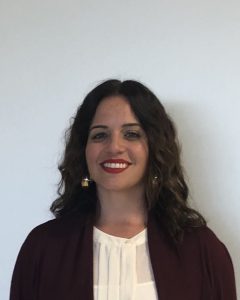
Melissa M. Ramos Borges is an art historian with a predilection for the (re)vision of the discipline. She obtained her doctorate from the Programa de Estudios Artísticos, Literarios y Culturales with a specialty in Art History at the Universidad Autónoma of Madrid, where she presented the first comprehensive study of avant-garde art produced between 1960-1980 in Puerto Rico. She is a professor of Art History and Theory at the University of Puerto Rico, Mayagüez and Río Piedras Campus. In addition, she is an independent researcher and curator who has published and presented her exhibitions and articles in various international platforms. She curated SUZI FERRER, the first retrospective exhibition of the groundbreaking feminist avant-garde artist, presently on view at the Museo de Arte y Diseño de Miramar. She is currently working on publishing a catalogue with contributions from various scholars which will accompany an upcoming traveling SUZI FERRER exhibition.

Shenouda Rizkalla is a trained archaeologist with extensive experience in archaeological fieldwork, database and collections management, and community outreach. His current research focus is the museum’s role in preserving the local community identity, applied to the content and display of the Sharm El-Sheikh museum and build up a sustainable community outreach program by engaging the local population with the collection and relate the results to wider discussions of repatriation and post-colonial heritage management in Egypt. Rizkalla is an Egyptology PhD graduate from Helwan University-Egypt. His research to date has been diverse, working on recording and translating Ptolemaic Period hieroglyphics, creating and executing site management strategies, and addressing the looting of archaeological sites. He is a member of many excavations and site management missions inside Egypt since 2012. He has many Presentations and Invited Talks, Academic Reports and Publications.
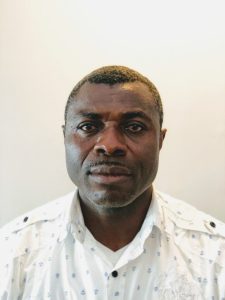
Nsima Stanislaus Udo is a Nigerian and an Africanist scholar. He completed his BA in History and International Relations in Ile-Ife, Nigeria. He then proceeded to South Africa where he completed his Honors and MA degrees (cum laude) at the University the Western Cape in Visual History and Theory. He lives in Cape Town and is a doctoral candidate at the University of the Western Cape. His research interest is in African cultural studies: in thinking around visual representations, histories and meanings of African cultural and festival practices. His doctoral research is currently looking at the history of Calabar Festival and Carnival, Nigeria. He is exploring the multiple-layered cultural, visual, aesthetic, economic and secular representations of this complex and elaborate festival. Nsima Stanislaus Udo presently serves as a teaching and research assistant at the Faculty of Art in the same university.
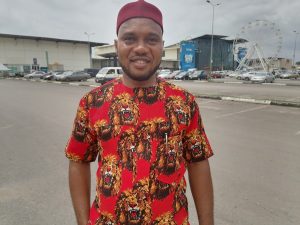
John Kelechi Ugwuanyi is a senior lecturer and the coordinator of postgraduate studies in the Department of Archaeology and Tourism, University of Nigeria, Nsukka. He had his PhD in heritage studies at the University of York and MA and BA in Archaeology and Tourism at the University of Nigeria. His research interest is critical heritage studies, museum, indigenous knowledge systems, tourism, and contemporary archaeology. He is the co-editor of Journal of African Cultural Heritage Studies and sits on the editorial board of the Studies in Contemporary and Historical Archaeology in Theory book series published by the Archaeopress in Oxford as part of the British Archaeological Report series of monograph. Kelechi has published in national and international journals of repute. He is a fellow of the American Council of Learned Societies and a recipient of other scholarship/grant including the Overseas Research Scholarship of the University of York, UK.
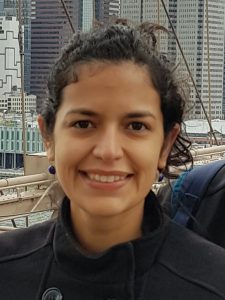
Elizabeth Catoia Varela holds a PhD in History and Criticism of Art from the Federal University of Rio de Janeiro, Brazil (2016). She worked at the Research and Documentation Center of the Modern Art Museum of Rio de Janeiro – MAM Rio (2009-2021). Her dissertation was published as a book in 2017 (Concrete Art Beyond Europe: Brazil, Argentina and the MAM Rio). She published other three books about the history of the museum. Varela was the curator of the exhibition “MAM: its history, its heritage” (2013-2016). She was awarded in 2020 with the AAM-Getty International Program/American Alliance of Museums and is a member of the College Art Association (CAA) and the International Council of Museums (ICOM).
PARTICIPATING ALUMNI

Nadhra Shahbaz Khan is Associate Professor of Art History and the Director of the Gurmani Centre for Languages & Literature at LUMS, Lahore, Pakistan. A specialist in the history of art and architecture of the Punjab from the sixteenth to the early twentieth century, Dr. Khan’s research covers the visual and material culture of the region during the Mughal, Sikh, and colonial periods. Her interest lies in investigating levels of human agency behind artefacts and architectural spaces, both as creators and consumers to understand their political, religious and socio-economic ambitions at different historical intersections. Her publications, conference papers and other research activities spread over more than a decade, especially her book titled Maharaja Ranjit Singh’s Samādhi in Lahore: A Summation of Sikh Architectural and Decorative Practices has successfully brought Sikh art and architecture to the forefront of Pakistan’s heritage discussions and conservation activities.
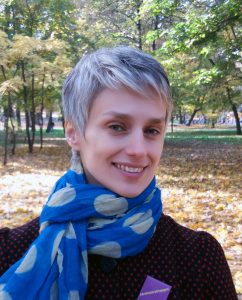
Halyna Kohut is an associate professor in the Faculty of Culture and Arts at the Ivan Franko National University of Lviv, Ukraine, where she teaches history of art, contemporary art, feminist art, and history of theatrical costume. Educated as an artist, she received her Ph.D. from the Lviv National Academy of Arts. Kohut is the CAA-Getty International Program alumna and a recipient of scholarships and grants from the Samuel H. Kress Foundation, Austrian Agency for International Mobility and Cooperation, the Canadian Institute of Ukrainian Studies at the University of Alberta, and the Queen Jadwiga Foundation at the Jagiellonian University in Cracow. Kohut specializes in eighteenth-century East European carpets and kilims. Her most recent research interest focus on woman art in Soviet Ukraine. She is especially interested in how ideology informed the identities of women artists and how they challenged that ideology with their art practices.
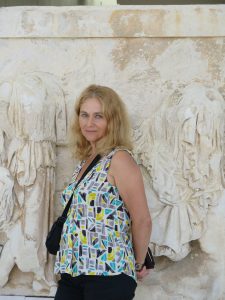
Irena Kossowska graduated from the Warsaw University in 1980. She obtained a Ph.D. degree and Habilitation at the Institute of Art of the Polish Academy of Sciences, in 1990 and 2001 respectively. Currently she is Full Professor of Art History at the Nicolaus Copernicus University in Torun, and at the Polish Institute of World Art Studies in Warsaw. She specializes in the field of nineteenth- and twentieth-century visual arts, art theory, and criticism. She is the recipient of numerous awards and fellowships, including from the Bogliasco Foundation, Center for Advanced Study in the Visual Arts, Smithsonian Institution, Zentralinstitut für Kunstgeschichte, National Humanities Center, Institut national d’histoire de l’art, Henry Moore Institute, and the British Academy. She has written extensively on Polish and European art, including Artistic Reconquest: Art in Interwar Poland and Europe, The Search for Cultural Identity in Eastern and Central Europe 1919-2014, Symbolism and Young Poland; Reinterpreting the Past: Traditionalist Artistic Trends in Central and Eastern Europe of the 1920s and 1930s; and The Beginnings of Polish Original Printmaking 1897-1917.
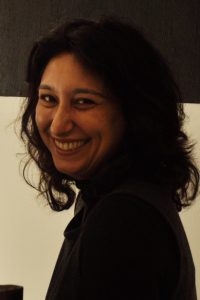
Ana Mannarino is an art historian and a professor of art history in the School of Fine Arts and the Visual Arts Postgraduate Program at the Federal University of Rio de Janeiro, where she received her PhD in history of arts and visual arts. Her research focuses on Brazilian modern and contemporary art, particularly on the relationship between text and image, art and poetry, and the production of artists’ books.
Announcing the CAA 2022 Annual Artists’ Interviews Speakers
posted by CAA — Oct 26, 2021
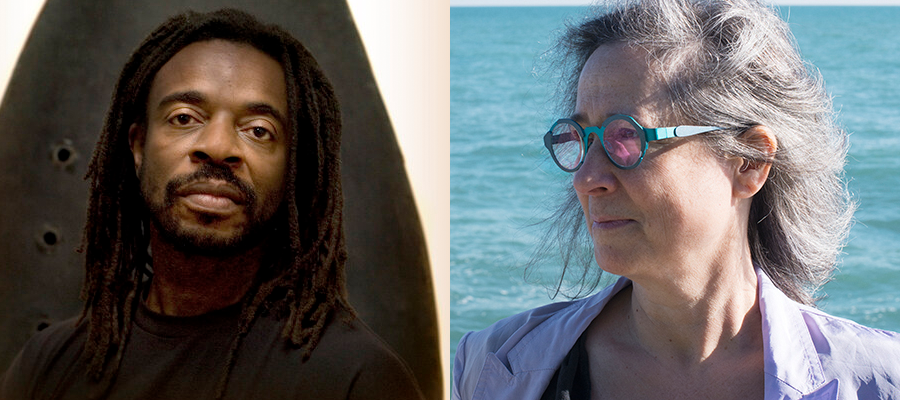
Willie Cole (left) and Jessica Stockholder (right).
We are excited to announce that CAA’s Annual Artists’ Interviews will feature Willie Cole and Jessica Stockholder. Each artist will take part in a one-on-one interview with a colleague during CAA’s 110th Annual Conference. These interviews will take place virtually on February 18, 2022.
Beginning in 1997, the Annual Artists’ Interviews were established to provide the opportunity for esteemed artists to have one-on-one conversations with colleagues at the Annual Conference. Each year, the Services to Artists Committee (SAC) identifies two distinguished artists to participate.
The interviews are held as part of the Services to Artists Program. Access to this program requires registration and is included with an All Access registration, or with stand-alone program registration at no cost. Recordings will be accessible to registrants after the event. Register here.
Speaker Biographies
Willie Cole is a contemporary American sculptor, printer, and perceptual engineer. His work uses contexts of postmodern eclecticism, and combines references and appropriation from African and African American imagery. Cole is best known for his Dada and Surrealist readymades, which assemble and transform ordinary domestic and used objects such as irons, ironing boards, high-heeled shoes, hair dryers, bicycle parts, wooden matches, lawn jockeys, and other discarded appliances and hardware. Cole grew up in Newark, NJ. He attended the Boston University School of Fine Arts, received his Bachelor of Fine Arts degree from the School of Visual Arts in New York in 1976, and continued his studies at the Art Students League of New York from 1976 to 1979.
Recent exhibitions of Cole’s work include To Reclaim, Kavi Gupta, Chicago, IL, USA; New Concepts in Printmaking 2: Willie Cole, MoMA, New York, NY, USA; Reconfiguring an African Icon: Odes to the Mask by Modern and Contemporary Artists from Three Continents, Metropolitan Museum of Art, New York, NY, USA; Chicago, Surrealism: The Conjured Life, Museum of Contemporary Art, Chicago, IL, USA; and Afro: Black Identity in America and Brazil, Tamarind Institute, Albuquerque, NM, USA. Cole’s work is in the permanent collection of the Whitney Museum of American Art, New York, NY; Walker Art Center, Minneapolis, MN; MoMA, New York, NY; National Gallery of Art, Washington, DC; High Museum of Art, Atlanta, GA; Studio Museum in Harlem, NY; Metropolitan Museum of Art, New York, NY; Museum of Contemporary Art, Chicago, IL; Albright-Knox Art Gallery, Buffalo, NY; and many others.
Jessica Stockholder is an internationally acclaimed visual artist and educator who lives and works in Chicago. In addition to earning her BFA from the University of Victoria in Canada and her MFA from Yale University, she was awarded two honorary Doctor of Fine Arts degrees: one from Emily Carr University of Art and Design in 2010, and one from Columbia College in 2013. Stockholder was Elected to the American Academy of Arts & Sciences in 2018.
Stockholder’s works sit at the intersection of painting with sculpture, and often incorporate the architecture in which it has been conceived. Employing a wide range of ordinary everyday materials Stockholder orchestrates an intersection of pictorial and physical space. She probes how meaning derives from physicality, and engages the sensuality and pleasure evoked by color and formal order in an effort to call attention to the edges of understanding.
Stockholder’s work has been exhibited in many of the world’s most influential art venues, including Centre Pompidou in Paris, the Dia Center for the Arts, the Whitney Museum of American Art, and the Venice Biennale. It is included in such museum collections as the Art Institute of Chicago, Whitney Museum of American Art, LACMA, and Stedelijk Museum in Amsterdam.
Stockholder is currently the Raymond W. & Martha Hilpert Gruner Distinguished Service Professor in the Department of Visual Arts at the University of Chicago, a position she accepted in 2011, after 12 years as Director of the Sculpture Department at the Yale School of Art.
An Inaugural Evening with CAA Distinguished Awardees and Artists
posted by Allison Walters — Sep 13, 2021
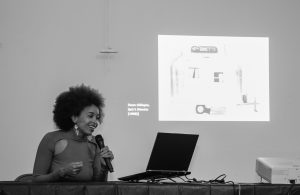
Nicole Fleetwood, recipient of CAA’s Frank Jewett Mather and Charles Rufus Morey book awards, discusses the inspiration behind her book, Marking Time: Art in the Age of Mass Incarceration.
Supporting excellence in the arts for over 100 years, CAA and its members are highly integrated into the fabric of art and its history, particularly in New York City. On September 1, 2021, CAA had the privilege to highlight its impact in an event featuring its distinguished awardees and partnerships. The event, an Inaugural Evening with CAA Distinguished Awardees and Artists, recognized the talent of CAA’s membership and reaffirmed CAA’s commitment and advocacy for scholars, artists, designers, teachers, young professionals, and many others.
Surrounded by recent artworks created by The League’s faculty members, CAA Executive Director and CEO Meme Omogbai introduced celebrated critic and curator Nicole R. Fleetwood. Fleetwood delivered a private presentation discussing her book and exhibition Marking Time: Art in the Age of Mass Incarceration, including detailed insights into the backstory and personal inspiration behind the important project. The book, published by Harvard University Press, unprecedently won both CAA’s Frank Jewett Mather and Charles Rufus Morey book awards in 2021. It was also reviewed across CAA’s publications, including The Art Bulletin, Art Journal, and caa.reviews. Fleetwood’s book accompanies a groundbreaking exhibition that began at MoMA PS1 in 2020 and continues to travel; it will open on September 17 at the Abroms-Engel Institute for the Visual Arts at the University of Alabama at Birmingham and be on view through December 11, 2021.
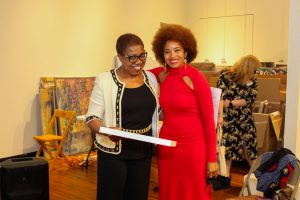
CAA Executive Director and CEO, Meme Omogbai, presents Nicole Fleetwood with the CAA Frank Jewett Mather and Charles Rufus Morey book awards.
The reception also commended CAA’s Outstanding Leadership in Philanthropy Award recipient, the Samuel H. Kress Foundation. The Samuel H. Kress Foundation has supported CAA in its mission for over 60 years, through programs in art history and, more recently, digital transformation. With support from the Samuel H. Kress Foundation, CAA’s new strategic focus on digital initiatives will bridge history, scholarship, and accessibility to better serve all segments of its constituency, especially underprivileged audiences.
The Art Students League of New York graciously hosted CAA for this event. Like CAA, The League is an organization with a long history of promoting the arts and education. Indeed, CAA and The League have been highly integrated into the fabric of art and its history in New York City and have been closely intertwined, collaborating on several events and initiatives dating back to at least the 1950s.
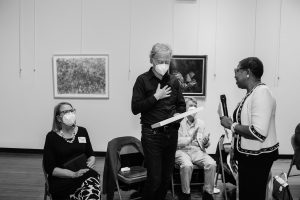
CAA Executive Director and CEO, Meme Omogbai, presents Max Marmor, President of the Kress Foundation, with the CAA Philanthropy Award.
Located west of The League, the site-specific exhibition Re:Growth, A Celebration of Art, Riverside Park, and the New York Spirit, curated by Karin Bravin, included several artists from the CAA community: current CAA Board Member Dahlia Elsayed, former Board President DeWitt Godfrey, and CAA member Jean Shin. While the weather prevented a group walk-through of the exhibition, Elsayed spoke to attendees about the unique exhibition, her sculpture in the show, and its significance.
Altogether, the evening underscored CAA’s wide reach and impact in the arts and the talent of its members. As the largest international organization of arts professionals, CAA has a vital mission to promote the visual arts and their understanding through intellectual engagement, commitment to diversity, and advocacy. This upcoming year will provide opportunities to celebrate several milestones in this mission. CAA’s next virtual event in November 2021, will celebrate the 10-year anniversary of the publication of CAA’s seminal history, The Eye, the Hand, the Mind: 100 Years of the College Art Association. In February 2022, CAA will host its first hybrid Annual Conference in Chicago and online; registration will open in October.
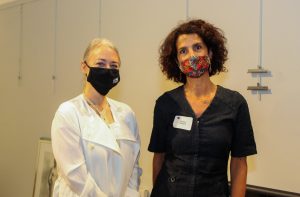
Jennifer Rissler, Vice President for External Relations and acting CAA Board President, and Dahlia Elsayed, current CAA Board Member and artist, both spoke at the event.
Global Conversations at the 2021 Conference
posted by Allison Walters — Feb 01, 2021
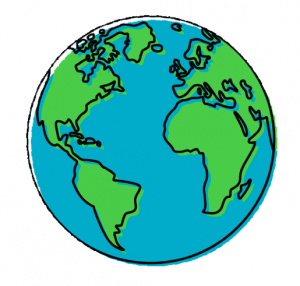
Celebrating Ten Years of the CAA-Getty International Program!
CAA-Getty Global Conversation I: The Migration of Art and Ideas
Live Q&A: Thursday, February 11, 10-10:30 AM
CAA-Getty Global Conversation II: The Climate Crisis, Pandemics, Art, and Scholarship
Live Q&A: Thursday, February 11, 12-12:30 PM
CAA-Getty Global Conversation III: The Challenges, Disobediences and Resistances of Art in the Transnational Imagination
Live Q&A: Friday, February 12, 12-12:30 PM
CAA-Getty Global Conversation IV: Disruptive Pedagogies and the Legacies of Imperialism and Nationalism
Live Q&A: Friday, February 12, 2-2:30 PM
CAA-Getty Global Conversation V: A Multiplicity of Perspectives at the Museum of Modern Art (In conversation with curators at MoMA)
Live Q&A: Saturday, February 13, 10-10:30 AM
See conference schedule for details:
https://caa.confex.com/caa/2021/meetingapp.cgi
2021 Distinguished Scholar: Salah M. Hassan
posted by Allison Walters — Nov 20, 2020
We’re delighted to announce the Distinguished Scholar session at the 109th CAA Annual Conference will honor Salah M. Hassan.
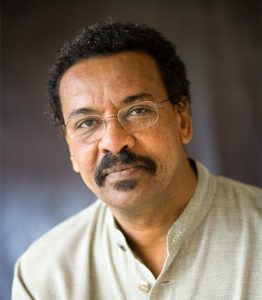
Salah M. Hassan. Photo: Jason Koski, Cornell University Photography (UREL)
Salah M. Hassan is the Goldwin Smith Professor of African and African Diaspora Art History and Visual Culture in the Department of Africana Studies and Research Center, as well as in the Department of History of Art and Visual Studies, and also serves as Director of the Institute for Comparative Modernities at Cornell University, Ithaca, USA. Hassan is also the Director of The Africa Institute, Sharjah, UAE. Hassan served as Professor of History of Art in African and African American Studies and Fine Art at Brandeis University, where he previously awarded the Madeleine Haas Russell Professorship in the Departments of African and Afro-American Studies and Fine Arts (2016-2017).
Hassan is a founding-editor of Nka: Journal of Contemporary African Art (Duke University Press). He currently serves as a member of the editorial advisory board of Atlantica, Journal of Curatorial Studies, and international Journal of Middle Eastern Studies, and served as consulting editor for African Arts. Hassan has contributed numerous essays to journals, anthologies, and exhibition catalogues of contemporary art, and has guest edited a special issue of SAQ: South Atlantic Quarterly, entitled African Modernism (2010). He has authored, edited, and co-edited several books, including Ibrahim El Salahi: A Visionary Modernist (2013); Darfur and the Crisis of Governance: A Critical Reader (2009); Diaspora, Memory, Place (2008); Unpacking Europe (2001); Authentic/Ex-Centric (2001; Gendered Visions: The Art of Contemporary Africana Women Artists (1997); and Art and Islamic Literacy among the Hausa of Northern Nigeria (1992), among others. Most recently, Hassan edited and introduced Ibrahim El-Salahi: Prison Notebook (MoMA and Sharjah Art Foundation Publications, 2018), and the forthcoming Ahmed Morsi: A Dialogic Imagination (Sharjah Art Foundation, 2020).
Hassan has curated a number of international exhibitions in museums and at major Biennales such as Venice and Dak’Art, including Authentic/Ex-Centric (49th Venice Biennale, 2001), Unpacking Europe (Rotterdam, 2001-02), and 3×3: Three Artists/Three: David Hammons, Maria Magdalena Campos-Pons, Pamela Z (Dak’Art, 2004), among others. He curated Ibrahim El Salahi: A Visionary Modernist was published in 2012 held at The Tate Modern in London (2013) after premiering at the Sharjah Art Museum in Sharjah, UAE (2013). In addition, he also co-curated The Khartoum School: The Making of the Modern Art Movement in Sudan, 1945-2016 (2016-2017) and When Art Becomes Liberty: The Egyptian Surrealists (1938–1965) (2016) funded by the Sharjah Art Foundation.
He is the recipient of fellowships including the J. Paul Getty Postdoctoral Fellowship as well as major grants from Sharjah Art Foundation, Ford Foundation, Rockefeller Foundation, Afrique en Créations, Andy Warhol Foundation for the Visual Arts, and the Prince Claus Fund.
This session will highlight his career and provide an opportunity for dialogue between and among colleagues. The panel will include Dr. Hassan as well as the following: Chika Okeke-Agulu (Princeton University); Elizabeth Giorgis (University of Addis Ababa); and Iftikhar Dadi (Cornell University).
The live online Q&A will be held Thursday, February 11, 2021, 10:30-11:15 am EST.
Submit Your Proposal for Graduate Screenings at the 2021 Annual Conference
posted by CAA — Sep 22, 2020

Film still from Tending Breadth (2019), courtesy of Heather Taylor and Jacklyn Brickman
CAA’s Services to Artists Committee (SAC) invites current graduate students (or 2020 graduates) to submit work for consideration in the 2021 Graduate Screenings: Film/Video, Animations, & New Genres program for the upcoming 109th Annual Conference in February 2021. For the conference, SAC will screen the selected winners online.
Through this screening and exhibition initiative, SAC aims to give the next generation of artists and practitioners an opportunity to display their work in a national forum. Our annual Graduate Screenings celebrates the hard work of graduate students across the nation and world, while exposing their artworks to a broad audience. We look forward to reviewing your submission.
Eligibility
Applicants must be enrolled currently in an MFA (or equivalent MA or PhD) program OR have graduated from a program in the spring or summer of 2020. Due to the university shutdowns in the spring of 2020, SAC will accept submissions from recent 2020 program graduates.
Please use the form below to submit your entry. Submission for consideration is free and membership with CAA is not required (we are collecting this information for statistical purposes). All videos must follow the specifications and meet all technical requirements or they will not be accepted.
SAC Jurors
Farhad Bahram, Indiana State University; Robert Howsare, West Virginia Wesleyan College; Sue Huang, University of Connecticut; Richard Serrano, Art This Week Productions
Guest Juror
Ugochukwu-Smooth C. Nzewi, the Steven and Lisa Tananbaum Curator, Department of Painting and Sculpture at the Museum of Modern Art (MOMA)
Invited guest juror Ugochukwu-Smooth C. Nzewi will select one work from the SAC juried program to be awarded best in show.
Contact: servicestoartists@gmail.com; please include “Graduate Screening Question” in the subject line if you have a question
Deadline for submission: December 4, 2020
Acknowledgment of submission selection: January 19, 2021
Submissions Items for Application Form Input:
—First and last name
—Name of school and department
—Degree (MFA, PhD or MA) and major/concentration
—Year of graduation
—CAA member status (it is not required to be a member)
—If member, CAA membership number
—Narrative bio
—Artist statement
—Personal website (optional)
—Vimeo link (see specs below)
—Film still from your video to be used for promotion purposes (see specs below)
Video/Image Submission Specifications:
Please note that submissions missing any of the below specifications may be disqualified from consideration.
Video:
—5 minutes in maximum length (excerpts accepted)
—H.264 at 1920 x 1280px (MP4 file format)
—Include 2 opening title cards:
—1st card–5 seconds; include your full name (first and last), title of work, year of completion, name of school, department and/or program
—2nd card–5 seconds; include credits for music, sound, other camera people, editing. Even if these were you, include these credits
—Upload submission to Vimeo.com (include your link. Video must remain viewable on Vimeo until February 9th). —Selected participants will be required to upload their hi-res video file to a Google drive in late January and maintain their video on Vimeo till the end of the conference
Image:
—Still from video submission
—960 x 640px (landscape), 72 dpi (JPG file format)
New in caa.reviews
posted by CAA — Sep 11, 2020
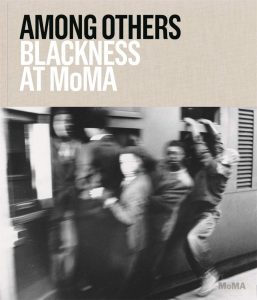
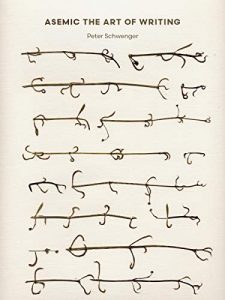
Martha Scott Burton considers Among Others: Blackness at MoMA, edited by Darby English and Charlotte Barat, about the museum’s history of representation and inclusivity. Read the full review at caa.reviews.
Peter D. McDonald examines a unique creative practice through Asemic: The Art of Writing by Peter Schwenger. Read the full review at caa.reviews.
CWA Picks for July 2020
posted by CAA — Jul 28, 2020
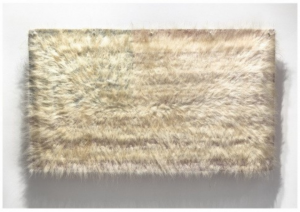
Sonya Kelliher-Combs (Native American, b. 1969) Mark, Polar Bear, 2019. Acrylic polymer, polar bear fur, fabric flag, metal brackets, 40 x 65 in. © 2019 Sonya Kelliher-Combs. Courtesy of the artist and Minus Space.
In response to COVID-19, artists, institutions, and organizations have initiated virtual exhibitions, presentations, screenings, and curated newsletters, among other innovative approaches, welcoming the public to online platforms and opening dialogues on a range of topics. May and June 2020 CWA Picks presented a number of initiatives that demonstrated ways in which social media channels and websites can be repurposed in light of social distancing measures currently in place; these Picks emphasized the social role of the arts as a healing positive force during these challenging times. As protests about systemic racism and structural injustices raged globally, museums and institutions were inclined to acknowledge their fundamental accountability and engagement in the misrepresentation or excision of Black and Indigenous histories from white imperialist and colonial narratives, including the prevalent or implicit use of racist language and practices. As the world witnesses and participates in “good trouble” and social unrest, our July Picks cover a range of online and in-person exhibitions and events and strike a balance between feminist ecologies of care and political activism. At this unprecedented historical juncture, some art spaces have opened their doors to audiences and slowly resumed activities, enforcing precautions and timed visits:
- ecofeminism(s) curated by Monika Fabijanska at Thomas Erben Gallery (7.19.20-7.24.20) takes us on a visual journey of the pioneering environmental art works of the 1970s and 80s through the present. Countering patriarchal and corporate structures and philosophies, many artists engage scientific and analytic approaches to experimental practices, utilizing photographic documentation, archives, time-based media, and ritual performances. Advancing principles of spiritual feminism, feminist metaphors of the Great Goddess and Cosmic Mother, and anti-nuclear activism, among other social and technological positions, the early eco–feminists underscore earth’s fragility and vulnerability—thinly veiling our fears and prophetically imagining our current global crises and pandemic—yet glimmers of care, community, and agency strikingly emerge. As an intergenerational show presenting contemporary women artists making ecological art, Fabijanska proposes, “What makes today’s female environmental artists ‘ecofeminists’?” Artists include Andrea Bowers, Helène Aylon, Eliza Evans, Sonya Kelliher-Combs, Hanae Utamura, Betsy Damon, Aviva Rahmani, Jessica Segall, Lynn Hershman Leeson, Bilge Friedlaender, Carla Maldonado, Mary Mattingly, Cecilia Vicuña, Barbara Kruger, and Agnes Denes. Public programming with Zoom conversations between artists, art historians, and critics: July 8, July 15, and July 22.
- Earthkeeping, Earthshaking – art, feminisms and ecology (Earthkeeping/Earthshaking – arte, feminismos e ecologia), curated by Giulia Lamoni and Vanessa Badagliacca at Galerias Municipais (Galeria Quadrum) in Lisbon (7.25.20-10.4.20) takes its title from the thirteenth issue of the pioneering US feminist art magazine called Heresies (1981) published by the feminist collective. Lucy Lippard, Ana Mendieta, and Faith Wilding, among other contributors to this issue, raised complex points around the following question: ‘What can women do about the disastrous direction the world is taking?’ Curators Lamoni and Badagliacca return to this pressing question in a global 21st-century context by reframing ideas of capitalism, colonialism, and current environmental pressures, further exploring a Portuguese perspective. Earthkeeping, Earthshaking presents radical feminist artists from the 1970s through the present day: Alexandra do Carmo, Alicia Barney, Ana Mendieta, Bonnie Ora Sherk, Cecilia Vicuña, Clara Menéres, Emilia Nadal, Faith Wilding, Gabriela Albergaria, Gioconda Belli, Graça Pereira Coutinho, Irene Buarque, Laura Grisi, Lourdes Castro. Maren Hassinger, Maria José Oliveira, Mónica de Miranda, Rui Horta Pereira, Teresinha Soares, Uriel Orlow.
- AWARE (Archives of Women Artists Research & Exhibitions) has launched the podcast Woman House in response to the pandemic. Each episode invites a female narrator to read stories and texts by women writers on the broad theme of confinement. For example, hear Virginia Woolf’s To the Lighthouse read by Julie Wolkenstein; Céleste Albaret’s Monsieur Proust read by Jeanne Balibar; and Marguerite Dumas’s Writing read by Camille Morineau.
- Virtual Views: Faith Ringgold at MoMA explores Ringgold’s extraordinary position in the sixties as an African-American woman painter and offers personal commentary about cultural identity and documentation during the civil rights movement. Ringgold’s American People Series #20: Die, a masterpiece from the museum collection, visualizes the realities of race, police brutality, and violence, and makes direct references to Picasso’s Guernica.
- Not Yet Written Stories is an online archival repository of avant-garde women artist practices (documentation, exhibitions, conferences, publications), supported by workshops and conferences. Managed by the SCCA-Ljubljana Center for Contemporary Arts, Arton Foundation, Warsaw, and Latvian Center for Contemporary Art (Riga), Office for Photography, Zagreb.
- Whitechapel Gallery offers an instructional list of audio resources (podcasts and audiobooks) on Black Lives Matter.
- Carla Repice: The White Problem Redux, an online exhibition at Equity Gallery, highlights the “optics of whiteness and the ways in which white supremacy virally replicates itself in visual culture,” according to the accompanying online essay by Ronika McClain. Repice’s intimate, gestural figurative paintings unveil quick glimpses into childhood, focused sharply on youth and education as primary source material for the formulation of implicit racism, symbols, and narratives. Public programming includes a series of poetry readings by Black writers, organized by poet Maya Pindyck.


